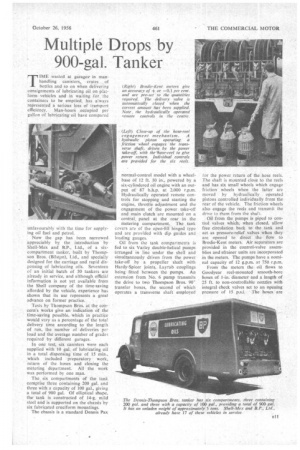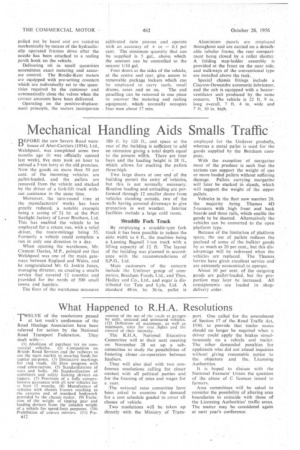Multiple Drops by 900-gal. Tanker
Page 45

Page 46

If you've noticed an error in this article please click here to report it so we can fix it.
TIlvIE wasted at garages. in manhandling canisters, crates of bottles and so on when deliverine consignments of lubricating oil on platform vehicles and in waiting for the containers to be emptied, has always represented a serious loss of transport efficiency..Man-hour S occupied per gallon of lubricating'oil have compared
unfavourably with the time for supplying oil fuel and petrol.
Now the gap has been narrowed appreciably by the introduction by Shell-Max and B.P., Ltd., of a sixcompartment tanker, built by Thompson Bros. (Bilston), Ltd., and specially designed for the carriage and rapid dispensing of lubricating oils. Seventeen of an initial batch of 50 tankers are already in service, and although official information is not yet available from the Shell company of the time-saving afforded by the vehicle, experience ha$ shown that its use represents a great advance on former practice.
Tests by Thompson Bros. at the concern's works give an indication Of the time-saving possible, which in practibe would vary as a percentage of the total delivery time according to the length of run, the number of deliveries per load and the average number of grade; required by different garages.
In one test, six canisters were each supplied with 10 gal, of lubricating oil in a total dispensing time of 15 min., which included preparatory work, return of the hoses and closing the metering department. All the work was performed by one man.
The six compartments of the tank comprise three containing 200 gal. and three with a capacity of 100 gal., giving a total of 900 gal. Of elliptical shape, the tank is constructed of 14-g. mild steel and is supported on the chassis by six fabricated cruciform mountings.
The chassis is a standard Dennis Fax normal-control model with a wheelbase of 12 ft. 10 in., powered by a six-cylindered oil engine with an output of 87 b.h.p. at 2,000 r.p.m. Hydraulically operated remote controls for stopping and starting the engine, throttle adjustment and the engagement of the power take-oft and main clutch arc mounted on a ceottal. panel at the rear in the . metering compartment. The . tank covers are of the open-fill hinged type and are provided with dip guides and loading gauges.
Oil from the tank compartments is fed to six Varley double-helical pumps arranged in line under the shell and simultaneously driven from the power .take-off by a propeller shaft with Hardy-Spicer joints, Layrub couplings being fitted between the pumps. An extension from No. 6 pump transmits the drive to two Thompson Bros. 90° transfer boxes, the second of which operates a transverse shaft employed for the power return of the hose reels. The shaft is mounted close to the reels and has six Small wheels which engage friction wheels when the latter are moved by hydraulically operated pistons controlled individually from the rear of the vehicle. The friction wheels also engage the reels and transmit the drive to them from the shaft.
Oil from the pumps is piped to control valves which, when closed, allow free circulation back to the tank and act as pressure-relief valves when they are opened to direct the flow to Brodie-Kent meters. Air separators are provided in the control-valve assemblies and strainer units are incorporated in the meters. The pumps have a nominal capacity of 12 g.p.m. at 750 r.p,m,
From the meters the oil flows to Goodyear reel-mounted smooth-bore hoses of 1-ip. diameter and a length of 25 ft to non-controllable nozzles with integral check valves set to an opening pressure of 15 p.s.i. • The hoses are pulled out by hand and are reeled-in mechanically by means of the hydraulically operated friction drive after the nozzle has been attached to a reeling perch hook on the vehicle.
Delivering oil in small quantities necessitates exact metering and accurate control. The Brodie-Kent meters arc equipped with pre-setting counters which are individually set to the quantities required by the customer and automatically close the valves when the correct amounts have been delivered.
Operating on the positive-displacement principle, the meters incorporate
calibrated twin pistons and operate with an accuracy of ± or — 0.1 per cent. The minimum quantity that can be supplied is 5 gal., above which the amount can be controlled to the nearest 1/10 gal.
Four doors at the sides of the vehicle, at the centre and rear, give access to removable package lockers which can be employed to carry tools, small drums, cases and so on. The end panelling can be removed in one piece to uncover the metering and reeling equipment, which normally occupies four men about 17 min, Aluminium panels are employed throughout and are carried on a detachable tubular frame, the rear compartment being closed by a roller shutter. A folding step-ladder assembly is provided at the front on the near side, and walkways of the conventional type are installed above the tank.
Special chassis fittings include a Clayton-Dewandre automatic lubricator, and the cab is equipped with a heaterventilator unit produced by the same concern. The vehicle is 22 ft. 9 in. . long overall. 7 ft. 4 in. wide and 7 ft. 10 in, high.




































































































